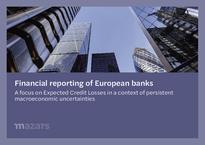Mazars study reveals how macroeconomic uncertainties impacted Expected Credit Losses (ECL) of the largest banks in Europe
- Report is based on Mazars’ analysis of information published in the interim reports of 26 banks across 11 European countries.
- Main findings reveal a decrease in the number of defaults, thanks to the support offered by different governments through the pandemic.
- War in Ukraine raises concerns over geopolitical instability and subsequent energy crisis that are creating increasingly challenging economic environment
The report reveals that over H1 2022, there has been a decrease in the number of defaults from the European banks analysed, mainly driven by support from respective governments through the pandemic. The analysis further shows that new concerns have arisen as the war in Ukraine continues in generating geopolitical upheaval and an energy crisis, increasing pressures on banks amidst economic conditions that are becoming increasingly challenging. This looks set to impact global markets in the long run.
The report is designed to serve as a practical benchmarking tool, helping credit institutions compare the impact of the macroeconomic climate on their business with their peers, Mazars will be returning next year with further research to see how these developments have affected banks and their ECL levels.
H1 2022 vs Year End 2021
The main findings in H1 2022, compared with YE 2021
- An average amortised cost loan coverage ratio that decreased compared with YE 2021 (1.42% in H1 2022 vs 1.54% in YE 2021), due to a lower coverage ratio for stage 3 and stage 2 instruments
- A global relative decrease in the weight of stage 3 exposures and loss allowances since YE 2021
- A slight decrease of post-model adjustments/overlays in ECL allowances compared with YE 2021 (15% of the loss allowances in H1 2022 vs 17% in YE 2021)
- Visible geographical trends in changes of ECL allowances and post-model adjustments, macroeconomic scenarios weightings and forward-looking information compared with YE 2021
- Limited direct impacts of the war in Ukraine, but economic uncertainties bearing on post-model adjustments in H1 2022
Exploring allowances, adjustments and overlays
The report covers a number of important topics such as:
- ECL charge impact of H1 2022 on the profit or loss and ECL allowances
- ECL allowances: changes in coverage ratios and allocation between stages
- Post-model adjustments and overlays
- Assessment of some of the forward-looking information contained in the banks’ annual reports, and investigation into how banks are preparing for the emerging financial effects of the ongoing war in Ukraine.
Impacts of the ongoing war in Ukraine on H1 2022 ECL
- The banks analysed in the report disclosed different quantitative information about exposures, such as on and off-balance sheet or % of total loan book, or impacts resulting from operations related to subsidiaries in Russia or Ukraine (e.g. loss of control or disposal of the subsidiary).
- Despite a different basis of comparison, no bank disclosed significant direct impacts stemming from the war in Ukraine.
The impacts of the war in Ukraine are reflected in 3 main different ways in terms of provisions for ECL:
- Transfers of Russian and Ukrainian counterparties in Stage 2 or Stage 3
- Update of macroeconomic scenarios
- Net ECL charge through specific overlays or post-model adjustments
Click here to download the full report.
###
Methodology
This study is based on information disclosed in the interim reports of participating banks, without taking into account any press releases, investor-oriented presentations or similar publications. Each bank is represented by an alphanumeric code composed of two letters, for instance, FR for France, and a number. When the sample presents only one bank in a country, to keep it anonymous, the country code is “O” for “other countries”.
To increase comparability, we have chosen relevant indicators disclosed by a majority of the banks in the sample. Therefore, when a bank does not appear in a graph, it means they did not disclose data relevant to that graph. Some figures presented, such as the ECL coverage ratio, have been calculated using input data from the annual reports. The detailed methodology for producing such figures is explained in each graph in the attached report.
Contacts
Lorraine Hackett, Group Brand & Communications Director, Mazars: lorraine.hackett@mazars.co.uk // +44 (0)20 7063 4435
About Mazars
Mazars is an internationally integrated partnership, specialising in audit, accountancy, advisory, tax and legal services*. Operating in over 90 countries and territories around the world, we draw on the expertise of more than 42,000 professionals – 26,000+ in Mazars’ integrated partnership and 16,000+ via the Mazars North America Alliance – to assist clients of all sizes at every stage in their development.
*where permitted under applicable country laws.

